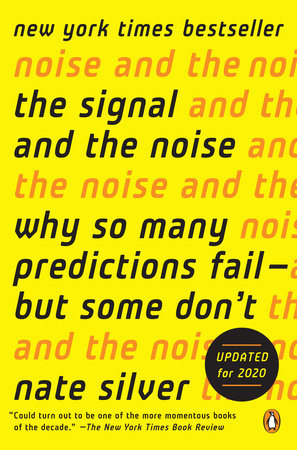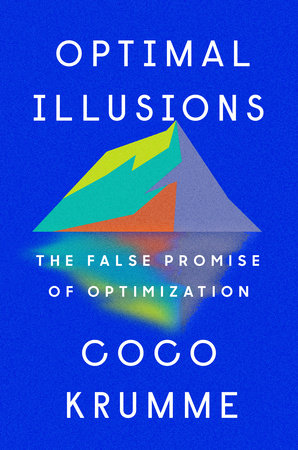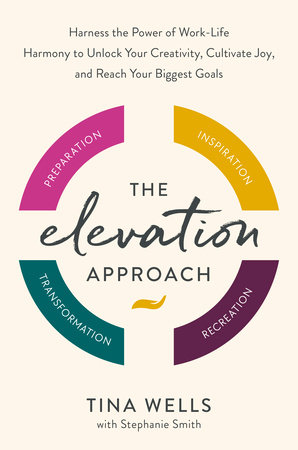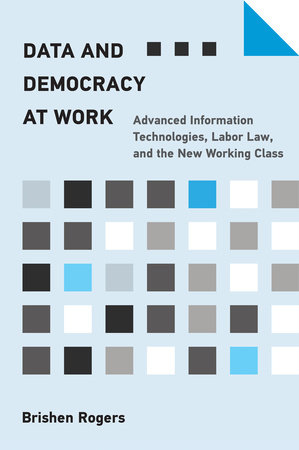Quick Summary
One Sentence Summary
“The Signal and the Noise” by Nate Silver explores the science of prediction, dissecting why so many predictions fail but some don’t.
Big Idea
The big idea is that by understanding and applying statistical principles, we can distinguish meaningful signals from mere noise, thereby improving our predictions in various fields.
Five Key Ideas
- Overconfidence in Predictions: The book demonstrates how experts often overestimate their predictive abilities, leading to significant errors.
- Signal vs. Noise: Silver emphasizes the importance of differentiating between relevant data (signal) and irrelevant data (noise) in making accurate predictions.
- Bayesian Thinking: The book introduces Bayesian statistics as a powerful tool for updating predictions based on new evidence.
- Application Across Fields: It shows how the concepts apply to various domains, including politics, economics, weather, and sports.
- Limitations of Predictions: Silver acknowledges the inherent limitations and uncertainties in prediction, advocating for humility and continuous learning.
Actionable Advice
- Embrace Uncertainty: Acknowledge the uncertainties in predictions and use probabilistic thinking.
- Seek Diverse Information: Avoid echo chambers and seek diverse data sources to challenge your assumptions.
- Apply Bayesian Thinking: Continuously update your beliefs and predictions as new information emerges.
About the Author
Nate Silver is a renowned statistician and writer, famous for his accurate political forecasts and the founder of the website FiveThirtyEight.
Read Next
- “Thinking, Fast and Slow” by Daniel Kahneman: For insights into how our thinking processes affect our decisions and predictions.
- “Superforecasting: The Art and Science of Prediction” by Philip E. Tetlock and Dan Gardner: For a deep dive into what makes some people remarkably good at forecasting.
- “Freakonomics” by Steven D. Levitt and Stephen J. Dubner: For exploring the hidden side of everything and unconventional approaches to data.
In Depth
Overconfidence in Predictions
Overconfidence in predictions is a pervasive problem. Experts often believe their forecasts are more accurate than they really are. This overconfidence can lead to significant errors and flawed decision-making. In “The Signal and the Noise,” Nate Silver delves into this issue, demonstrating how even seasoned professionals can fall prey to this cognitive bias.
A detailed example from the book involves earthquake predictions. Seismologists, despite their expertise, struggle to predict earthquakes accurately. Silver cites the L’Aquila earthquake in Italy, where experts reassured the public that a major quake was unlikely, only for a devastating one to strike soon after. This incident tragically highlights the consequences of overconfident predictions.
Silver’s examination of this event reveals a deeper problem in predictive science. Experts often rely on incomplete data or models that can’t capture the complexity of natural phenomena. When they present their predictions with unwarranted certainty, it can lead to misplaced trust and poor decision-making.
Silver aptly points out, “The most calamitous failures of our time have often been the product of overconfidence.” This quote underscores a crucial message of the book: the need for humility in the face of uncertainty. Predictions, no matter how expertly made, are not certainties. They are best-guess estimates based on available data.
To combat overconfidence, Silver suggests adopting a more probabilistic way of thinking. Instead of making absolute forecasts, experts should express their predictions in terms of probabilities. This approach not only acknowledges uncertainty but also allows for the continuous updating of predictions as new information comes to light.
Moreover, Silver stresses the importance of learning from past errors. A predictive model is only as good as its ability to adapt and improve. Experts should critically analyze where their predictions went wrong and refine their models accordingly. This process of continuous learning and adaptation is key to improving the accuracy of predictions over time.
The idea of overconfidence in predictions extends beyond earthquake forecasting. It permeates various fields, from economics to politics. Recognizing and addressing this issue is crucial for better decision-making. Whether it’s policymakers relying on economic forecasts or voters influenced by political polling, understanding the limits of predictions can lead to more informed choices.
In essence, overconfidence in predictions is a reminder of the complexities of the world we try to forecast. It calls for a balance between confidence in our methods and humility in the face of uncertainty. As Silver’s book illustrates, this balance is not just a statistical necessity but a practical one, affecting real decisions and, at times, real lives.
Signal vs. Noise
Distinguishing between what’s important (signal) and what’s not (noise) is crucial. In “The Signal and the Noise,” Nate Silver emphasizes this concept. It’s about filtering the meaningful data from the irrelevant. This discernment is key to making accurate predictions.
A standout example from the book is weather forecasting. Weather predictions have improved over the years. This improvement is partly due to better technology. But, it’s also because meteorologists have become adept at identifying signals amidst noise. They focus on relevant data and ignore misleading information.
Silver explains, “The signal is the truth. The noise is what distracts us from the truth.” This quote highlights the core of the challenge. In a world inundated with data, identifying what truly matters is both an art and a science.
In weather forecasting, the signal might be atmospheric pressure patterns indicating a storm. The noise could be short-term fluctuations that don’t impact the overall trend. By focusing on the signal, meteorologists can provide more reliable forecasts.
This concept extends beyond weather. In economics, for instance, the signal could be long-term growth trends. The noise might be short-term market fluctuations. By focusing on the signal, economists can make better predictions about economic health.
In sports, the signal could be a team’s overall performance metrics. The noise might be a single game’s outcome. By focusing on the signal, analysts can better predict future performance.
The challenge, as Silver points out, is that the signal is often weak and hard to detect. Meanwhile, the noise is loud and distracting. The key is to develop methods and models that enhance the signal while filtering out the noise.
This requires critical thinking and skepticism. It’s easy to mistake noise for a signal, especially when it confirms our biases. Experts need to question their assumptions and rigorously test their models against reality.
Silver also underscores the role of data quality. More data isn’t always better. In fact, more data can amplify noise. The focus should be on relevant, high-quality data. This approach increases the chances of finding true signals.
In a broader sense, the concept of signal versus noise is about focus. It’s about concentrating on what really matters and not getting sidetracked by distractions. Whether in professional forecasting or daily life, this principle holds true.
In summary, distinguishing signal from noise is a foundational concept in making accurate predictions. It’s about honing in on the truth and avoiding distractions. As Silver’s book illustrates, this distinction is a critical skill in a world overflowing with information.
Bayesian Thinking
Bayesian thinking is about updating beliefs with evidence. In “The Signal and the Noise,” Nate Silver introduces this as a powerful approach for refining predictions. It’s a method of statistical inference that adjusts probabilities as new data comes in.
A detailed example from the book is baseball statistics. Baseball, with its wealth of data, is ideal for applying Bayesian methods. Silver explains how baseball scouts traditionally relied on their experience and intuition to evaluate players. But with the advent of more sophisticated statistical analysis, like sabermetrics, there’s a shift. Now, they can update player assessments more accurately based on ongoing performance data.
Silver articulates, “Bayes’s theorem is to the theory of probability what Pythagoras’s theorem is to geometry.” This quote signifies the fundamental nature of Bayesian thinking. Just as Pythagoras’s theorem is a foundational principle in geometry, Bayesian thinking is foundational in understanding probabilities.
In practice, Bayesian thinking starts with a prior belief or hypothesis. As new data emerges, you adjust this belief. The process is continuous. Every piece of evidence refines your understanding and prediction.
For example, if a baseball player starts hitting more home runs, a Bayesian approach would increase the probability of that player being a power hitter. This adjustment is based on the new evidence, not just past performance.
This approach contrasts with more traditional, static methods of prediction. In traditional methods, predictions are often based on fixed models. They don’t adapt well to new information. Bayesian thinking, on the other hand, is dynamic. It evolves with every new piece of data.
The key advantage of Bayesian thinking is its flexibility. It embraces uncertainty and quantifies it. Instead of making rigid predictions, it offers probabilistic estimates that can change over time.
But Bayesian thinking also requires caution. The starting point, or the prior, can heavily influence the outcome. If the prior is biased or flawed, it can lead to skewed results. Therefore, selecting an appropriate and objective prior is crucial.
In broader terms, Bayesian thinking is not just a statistical tool. It’s a mindset. It’s about being open to new information and willing to adjust your beliefs accordingly. It applies not only in statistics but also in everyday life. Whether it’s re-evaluating an opinion or making a business decision, incorporating new evidence is essential.
In conclusion, Bayesian thinking, as presented by Silver, is a crucial key idea for improving predictions. It’s about updating beliefs with evidence, staying flexible, and continuously refining our understanding. This approach is not just a statistical method; it’s a way of thinking that can be applied in various aspects of life.
Application Across Fields
Nate Silver’s “The Signal and the Noise” demonstrates that predictive principles are universal. They apply across various domains, from politics to sports. Understanding and utilizing these principles can significantly enhance prediction accuracy in diverse fields.
A compelling example from the book is political forecasting. Silver gained fame for his accurate predictions in the 2008 and 2012 U.S. presidential elections. He used statistical models that combined polls, economic data, and other variables. These models weren’t just about aggregating polls. They were about identifying underlying patterns and adjusting for biases.
Silver notes, “The numbers have no way of speaking for themselves. We speak for them. We imbue them with meaning.” This quote emphasizes that data isn’t self-explanatory. Its interpretation and application are what matter. In politics, this means understanding voter behavior, polling methodologies, and the broader socio-economic context.
In economics, predictive principles help in forecasting market trends and economic shifts. While perfect prediction is impossible, models based on economic indicators can provide valuable insights. They help economists and policymakers anticipate and respond to changes.
Weather forecasting is another field where these principles shine. As mentioned earlier, meteorologists use data to predict weather patterns. Advances in data analysis have significantly improved weather predictions, making them more reliable and precise.
In sports, statistical analysis transforms how players and teams are evaluated. Baseball, for instance, has seen a revolution in player assessment through sabermetrics. This approach uses statistical analysis to measure in-game activity, providing a more nuanced understanding of a player’s value.
The application of predictive principles in these diverse fields shows their versatility. But it also highlights a common challenge: the complexity of real-world phenomena. No matter the field, predictions involve dealing with uncertainties and unknowns.
Silver stresses the importance of a nuanced approach. It’s not about finding a one-size-fits-all model. It’s about adapting models to the specificities of each field. This adaptation requires domain expertise and a deep understanding of the variables at play.
In summary, the application of predictive principles across various fields is a testament to their versatility and utility. Whether it’s politics, economics, weather, or sports, these principles provide valuable tools for making sense of complex data. They enable experts to make informed predictions, even in the face of uncertainty. However, their successful application requires careful interpretation and an understanding of each field’s unique challenges and dynamics.
Limitations of Predictions
Nate Silver’s “The Signal and the Noise” doesn’t just celebrate the power of predictions; it also acknowledges their inherent limitations. Understanding these limitations is crucial for realistic expectations and better decision-making.
A prime example from the book is the 2007-2008 financial crisis. Many economic models failed to predict the collapse. These models often relied on assumptions of market efficiency and stability, which proved disastrously incorrect. This crisis illustrates how complex systems can defy even the most sophisticated predictive models.
Silver aptly observes, “The more dynamic the system, the more unpredictable it becomes.” This quote underscores a fundamental challenge in prediction: dynamic, complex systems are inherently difficult to predict. They can change rapidly and unexpectedly, often in ways that models fail to capture.
In economics, this means recognizing the limitations of models in predicting market crashes or rapid shifts in consumer behavior. In politics, it means understanding that voter sentiments can change swiftly, influenced by a multitude of factors.
Weather forecasting, despite advancements, also has its limitations. While short-term forecasts have become quite accurate, long-term predictions remain challenging. The chaotic nature of weather systems means that small changes can lead to vastly different outcomes.
In sports, unpredictability is part of the excitement. While statistical analysis can provide insights, it can’t account for every variable. Injuries, team dynamics, and individual performances can all defy expectations.
Acknowledging these limitations is not a sign of defeat. It’s a call for humility and continuous improvement. It means being open to the possibility that predictions can be wrong and being prepared to adapt when they are.
Silver emphasizes the importance of probabilistic thinking in dealing with these limitations. Instead of making absolute predictions, expressing forecasts in terms of probabilities can better reflect uncertainties. It also allows for more flexibility in adjusting predictions as new information becomes available.
Moreover, recognizing limitations encourages a critical examination of models and methods. It prompts experts to question their assumptions, test their models rigorously, and refine them based on real-world feedback.
In a broader sense, the limitations of predictions remind us of the complexities and uncertainties of the world. They highlight the need for a balanced approach, one that combines data analysis with practical wisdom and domain expertise.
In conclusion, understanding the limitations of predictions is a key idea in “The Signal and the Noise.” It’s about acknowledging the uncertainties and complexities inherent in predicting dynamic systems. This understanding fosters a more nuanced and flexible approach to forecasting. It encourages continuous learning and adaptation, essential for improving predictions in an ever-changing world.
Actionable Advice
- Distinguish Signal from Noise: Focus on relevant data and ignore distractions. Avoid mistaking irrelevant details for meaningful information.
- Embrace Bayesian Thinking: Continuously update your beliefs and predictions with new evidence. Stay flexible and adaptable.
- Apply Across Fields: Utilize predictive principles in diverse domains. Adapt models to specific contexts and challenges.
- Understand Limitations: Recognize the inherent uncertainties in predictions. Be prepared to adapt when predictions are off.
- Use Probabilistic Thinking: Express forecasts in terms of probabilities, not absolutes. This reflects uncertainties and allows for flexibility.
- Question Assumptions: Regularly scrutinize your models and methods. Challenge your assumptions and biases.
- Focus on Quality Data: Prioritize relevant, high-quality data over sheer quantity. More data isn’t always better; it can amplify noise.
- Combine Data with Expertise: Blend data analysis with practical wisdom and domain knowledge. Data alone isn’t sufficient for accurate predictions.
- Learn from Mistakes: Use incorrect predictions as learning opportunities. Analyze why predictions failed and refine your approach.
- Stay Humble: Acknowledge that no prediction is foolproof. Stay open-minded and ready to adjust your views.
About the Author
Nate Silver is an American statistician, writer, and the founder of the influential website FiveThirtyEight. Born on January 13, 1978, in East Lansing, Michigan, he developed an early interest in statistics and baseball. Silver gained public recognition for developing PECOTA, a system for forecasting the performance and career development of Major League Baseball players. His accurate predictions in the 2008 and 2012 U.S. presidential elections brought him widespread acclaim.
Silver’s work emphasizes the importance of statistical analysis in decision-making. He advocates for Bayesian thinking, updating beliefs with new evidence, and is known for his approach to dissecting complex data. His book “The Signal and the Noise” has been a New York Times bestseller, reflecting his influence in the field of predictive analytics.
Believing in the power of data-driven insights, Silver is also vocal about the limitations of predictions, especially in complex systems. He champions humility in forecasting and urges the incorporation of uncertainty into prediction models. Through FiveThirtyEight, Silver continues to contribute to political analysis, sports, economics, and more, always with a focus on how data shapes our understanding of the world.
Read These Next
You might like these similar books
- “Freakonomics” by Steven D. Levitt and Stephen J. Dubner
- “Thinking, Fast and Slow” by Daniel Kahneman
- “Superforecasting: The Art and Science of Prediction” by Philip E. Tetlock and Dan Gardner
- “Predictably Irrational: The Hidden Forces That Shape Our Decisions” by Dan Ariely
- “Black Swan: The Impact of the Highly Improbable” by Nassim Nicholas Taleb
FAQ
Q: What is the main theme of “The Signal and the Noise”?
A: The book focuses on making better predictions by distinguishing meaningful information (signal) from irrelevant data (noise).
Q: Does Nate Silver provide techniques for improving predictions?
A: Yes, Silver discusses Bayesian thinking and probabilistic forecasting as key techniques for refining predictions.
Q: Can the concepts in the book be applied to fields other than statistics?
A: Absolutely. Silver applies his principles to various domains like politics, economics, and sports.
Q: Does the book cover the limitations of predictions?
A: Yes, it emphasizes the inherent uncertainties and limitations in predicting complex systems.
Q: Is “The Signal and the Noise” suitable for readers without a statistics background?
A: Yes, it’s written in accessible language and explains concepts clearly for a general audience.
Q: How does Nate Silver’s background influence the book?
A: Silver’s experience in sports statistics, political forecasting, and data analysis heavily informs the insights and examples in the book.







